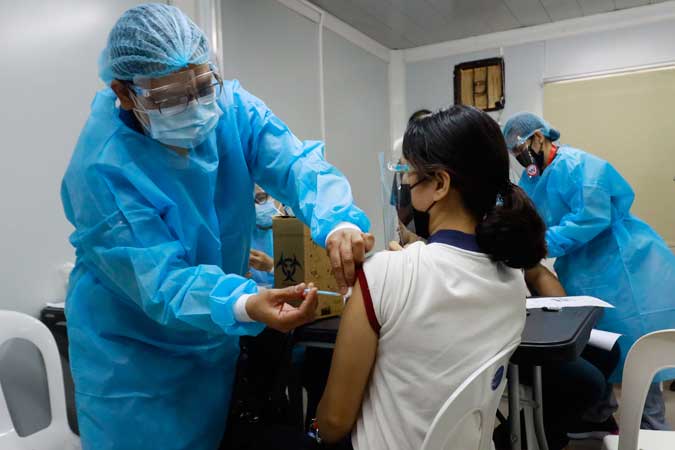Still thinking of what to write for the column on the eve of submission, I received a text message from an old friend, Doc Rogie Tangco. Rogie said he was perplexed by the media’s negative slant on vaccines.
Rogie’s message gave me a topic to write about. I do listen to Rogie for both personal and professional reasons. On a personal level, he is our family doctor. Upon hearing of my wife Mae’s death, he was the first to visit her at the hospital. On a professional level, Rogie is one of the country’s leading cardiologists. More, he is very involved among the health professionals in the fight against COVID-19.
The first part of Rogie’s message was a question: “What is the bigger problem?” Is it the supply of vaccines and their rollout or the hesitation of the majority of Filipinos to get the vaccine?
As of April 27, the Philippine Daily Inquirer (PDI) computed that those fully vaccinated constituted 0.22% of the Philippine population. Since then, based on official data, the total number of doses administered has more than doubled, from 1,809,801 doses (from PDI, as of April 27) to 3,718,308 doses (from Reuters, as of May 21).
The supply, however, has begun to pick up. The Philippines recently obtained 193,050 doses of Pfizer from the World Health Organization’s COVAX facility. This is but the initial batch of the 1.3 million Pfizer doses coming from the COVAX facility. In addition, more than two million doses of AstraZeneca arrived in early May, likewise coming from the COVAX facility. On top of this, four million doses of Sinovac and Gamaleya vaccines are expected to arrive this May.
The saddening news relates to public acceptance of vaccination. The latest Social Weather Stations (SWS) survey (April 28 to May 2) reported that 32% of adult Filipinos would like to be vaccinated. Almost the same number (33%) of Filipinos said they were unwilling to be vaccinated, and the remaining 35% said they were uncertain.
Pulse Asia’s March 2021 survey showed that only 16% of adult Filipinos wanted to be vaccinated. Moreover, 61% would not like to get vaccinated, and 23% said they could not say whether to take the vaccine.
One may notice an improvement in the number of those willing to be vaccinated based on the latest survey. But note that the SWS and Pulse Asia surveys use different survey methods and instruments. The bottom line: The majority of the people are either unwilling or reluctant to be vaccinated. That does not bode well for the country achieving herd immunity.
Rogie and I thus think the bigger problem is not the supply but the vaccine hesitation. Even if we solve the supply problem, vaccination would suffer, given low demand.
In this light, Rogie asked: “Why is there a plethora of news about the side effects… and not on the statistics that the higher the vaccination rate, the lower the infection, hospitalization, and death rates?”
Side effects occur, but in most cases they are minor. As Rogie pointed out, the serious side effects are rare. His point is that exaggerating bad news, like the serious side effects of vaccines, only aggravates the situation of vaccine hesitancy. Do note that the main reason behind vaccine hesitancy has something to do with the side effects of vaccination.
Rogie asked further: Is this because bad news sells? It is perhaps the nature of the beast for media to sensationalize the news in the internet age. Click baiting is the name of the game. But this is dangerous, especially when the whole of society is facing an unprecedented crisis like a pandemic.
Before receiving Rogie’s text, I likewise received a forwarded Viber message regarding the death of a Makati Medical Center doctor “within about a week” after receiving his second dose of Sinovac vaccine. This was fake news that was circulating, which an office colleague innocently sent to our Viber group.
In fairness to the media, they called out the fake malicious story. One newspaper published the story wherein the Makati Medical Center director refuted reports that that his colleague “died after completing his two doses of Sinovac vaccine.” But here’s the rub. This crucial sentence was buried in the news story.
Worse, the title of the story was: “Inoculated doctor dies of COVID-19” (Philstar, April 22, 2021). That can be misconstrued as saying that the doctor’s inoculation was pertinent to his death. A responsible writer or editor would have chosen a factual title: “Doctor dies of COVID-19.” That, however, would make the story no longer newsworthy.
Moreover, to uphold truth, the writer or editor should have titled the story: “Makati Medical Center counters fake news on doctor’s death.”
Here’s another example. The title of the front-page story of The Philippine Star on April 24, 2021 can mislead: “FDA reports 24 deaths following vaccination.” To have perspective, 24 people out of more than a million who got vaccinated died, and 19 of the 24 deaths were coincidental, or unrelated to vaccination.
The two examples are not isolated cases. Doc Rogie has observed a “plethora” of stories that tend to undermine the vaccination program.
This trend compelled the Department of Health and the Department of Science and Technology to issue a statement (April 16) calling out “media institutions continuing to publish disinformation on COVID-19 vaccines.”
Doc Rogie and I thus appeal to the media — both traditional and social — to exercise caution in spreading inaccurate news or misinformation. Further, we must expose and shame those who peddle fake news on vaccination. They are health saboteurs.
Vaccine disinformation is most harmful, all the more when our people are reluctant from getting vaccinated. We need to reassure our people about the safety and efficacy of all vaccines that have been granted emergency use authorization. As experts like Doc Rogie would say, “the best vaccine is the one that reaches my arm first.”
Filomeno S. Sta. Ana III coordinates the Action for Economic Reforms.

